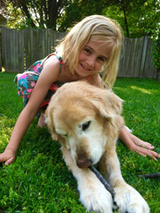Giant Omphalocele: Charlotte's Story
Giant Omphalocele: Charlotte's Story
Lindsay Groff first heard of giant omphalocele at a routine 20-week ultrasound during her first pregnancy, when her unborn daughter Charlotte was diagnosed with the abdominal wall defect. Seven years later, you'd never know how sick Charlotte once was.

Seen in approximately 1 in 10,000 births, giant omphalocele causes abdominal organs to protrude into the base of the umbilical cord.
Just over the river in New Jersey, Lindsay quickly made an appointment to get a second opinion at The Children’s Hospital of Philadelphia. It was there, at the Center for Fetal Diagnosis and Treatment, that she learned the extent of the diagnosis and what it would mean for her baby.
An omphalocele can vary drastically in size, containing anywhere from a portion of the small intestine to most of the abdominal organs. In the case of giant omphalocele, the majority of the liver protrudes into the umbilical cord, often resulting in underdeveloped lungs and a small abdomen, two factors that frequently cause complications after birth.
Babies with omphalocele are also at an increased risk for other birth defects, such as cardiac or neural tube defects, and intestinal and urological anomalies.
Finding omphalocele experts
Learning that Charlotte’s condition would require many delicate surgeries and time in the Newborn/Infant Intensive Care Unit (N/IICU), Lindsay knew that she wanted the best. And being able to deliver on site in CHOP’s Special Delivery Unit (SDU), the world’s first birth facility specifically designed for mothers carrying babies with known birth defects, was another important element of the care available.
Not only would Charlotte have immediate access to a specialized team of experts with more experience than any other doctors in repairing giant omphalocele, but both mom and baby would be cared for in the same location before and after delivery.
“It comforted me to know that the team that would be caring for us offered more experience than any other program in the world with repairing giant omphalocele,” says Lindsay. “I was under great care at a hospital in New Jersey, but at CHOP we would be surrounded by doctors who specialize in treating the sickest children.”
Groff underwent a comprehensive evaluation at the Center, which included detailed fetal imaging tests, and met with the multidisciplinary team that would be treating her and her baby to go over treatment options and what to expect throughout the pregnancy.
Right from the start, Lindsay knew she had made the right choice.
“Everyone I encountered, from scheduling and filling out paperwork to my appointments, was so caring and thoughtful,” she says.
Welcoming Charlotte to the world
Charlotte was born by C-section on May 18, 2010, in the SDU, where she was immediately evaluated and stabilized by the extensive team at her bedside. Babies with giant omphalocele often require a C-section delivery to avoid rupture of the omphalocele sac and liver trauma.
“She was surprisingly big, born with a full head of hair,” remembers Lindsay. “The hardest part was not being able to hold her. They wheeled her to me before taking her to the N/IICU, which was a great surprise, a special 10 minutes that I will cherish forever.”
In the N/IICU, Charlotte’s exposed organs were covered with a protective wrap. In some omphalocele cases, the organs gradually return to the abdominal cavity with the aid of gravity, but giant omphalocele sometimes requires several surgeries to repair the defect.
Surgical repair
On her second day of life, Charlotte underwent her first surgery right in the N/IICU under the care of an expert neonatal surgical team, a unique approach to care developed at CHOP that brings together an attending pediatric surgeon, an attending neonatologist and advanced practice nurses all specializing in the care of newborn surgical patients.
Charlotte’s surgery was performed by CHOP Surgeon-in-Chief N. Scott Adzick, MD, and over the next three months, she had a total of seven surgeries to put her abdominal organs back inside her body. The final surgical procedure closed her abdominal wall and gave her a belly button.
Charlotte stayed in the N/IICU for 14 weeks. After six weeks, she was off the ventilator and allowed to eat by mouth. But she struggled with exhaustion and many other complications that prevented adequate weight gain, so her feedings continued to be supplemented with a naso-gastric (NG) tube.
Mom’s greatest gift
During that time, Lindsay’s overwhelming memory is of feeling powerless. But there was one important thing she could do. Before Charlotte was born, Lindsay had met with Diane Spatz, PhD, from CHOP’s Breastfeeding and Lactation Program, to discuss the importance of breastfeeding.
Despite Charlotte’s struggles to eat by mouth, Lindsay could still contribute to her healing by pumping and freezing her breast milk to be used in Charlotte’s NG feeds. Breast milk provides optimal nutrition for babies with gastrointestinal problems. It is used as a kind of medical intervention, and at the same time it allows families to contribute to their baby’s care and recovery.

“I learned that my milk was a critical part of Charlotte’s care, not just food, but a powerful medicine that only I could give to her,” she says. “When everything seemed out of control, it was the one thing I could do for her.”
Once Charlotte was strong enough to be held, Lindsay practiced kangaroo care (promoting skin-to-skin contact), slowly and carefully bringing Charlotte steps closer to breastfeeding under the guidance of the nurses and certified lactation consultants.
“They were giving high fives in the N/IICU when she breastfed,” remembers Lindsay. "The support that I received allowed me to provide Charlotte with the best gift a mother can give her child."
Life after giant omphalocele
Today Charlotte is a talkative, clever, curious 7-year-old who is always on the move. Whether she’s climbing, jumping, dancing, riding her bike, or experimenting with her science kit, Charlotte is incredibly active, both physically and mentally, and continues to grow taller and stronger every day.
She returns to the Pulmonary Hypoplasia Program for follow-up visits to keep an eye out for any issues related to abdominal wall defects, like limited lung growth, neurodevelopmental growth and nutritional needs. As a toddler, Charlotte faced some obstacles reaching developmental milestones, but she has since made great strides in her development thanks to hard work with physical therapists and speech therapists. At a recent appointment, her family learned she has an above average IQ and is reading above her grade level.

Medically, Charlotte is just a “regular kid.” Her latest breakthrough involved no longer having to take daily penicillin to prevent risk of infection from a secondary condition that affected her spleen.
“She’s thriving and amazing,” says Lindsay. “From sun up to sun down, she always has something to say, making us laugh with the things she comes up with. To look at her now, you would never know that she was so very sick.”
As for Lindsay, her experiences feeding Charlotte in those early days came full circle when her career led her to a position as executive director of the Human Milk Banking Association of North America. She brings with her an understanding of just how much donated breast milk can mean for another family.
Originally posted: December 2012
Updated: November 2017